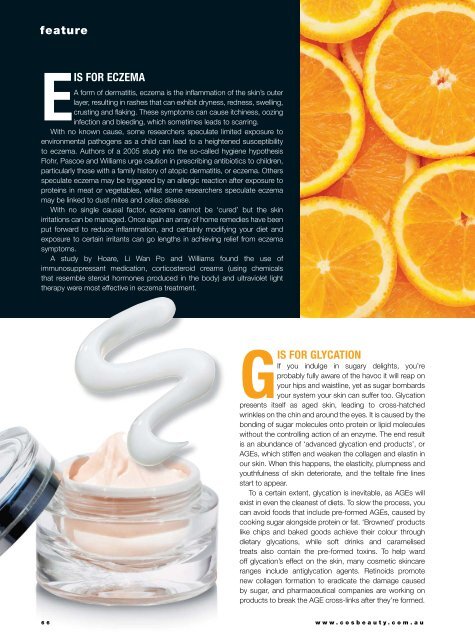Cosmetic Surgery and Beauty Magazine #68
You also want an ePaper? Increase the reach of your titles
YUMPU automatically turns print PDFs into web optimized ePapers that Google loves.
feature<br />
EIS FOR ECZEMA<br />
A form of dermatitis, eczema is the infl ammation of the skin’s outer<br />
layer, resulting in rashes that can exhibit dryness, redness, swelling,<br />
crusting <strong>and</strong> fl aking. These symptoms can cause itchiness, oozing<br />
infection <strong>and</strong> bleeding, which sometimes leads to scarring.<br />
With no known cause, some researchers speculate limited exposure to<br />
environmental pathogens as a child can lead to a heightened susceptibility<br />
to eczema. Authors of a 2005 study into the so-called hygiene hypothesis<br />
Flohr, Pascoe <strong>and</strong> Williams urge caution in prescribing antibiotics to children,<br />
particularly those with a family history of atopic dermatitis, or eczema. Others<br />
speculate eczema may be triggered by an allergic reaction after exposure to<br />
proteins in meat or vegetables, whilst some researchers speculate eczema<br />
may be linked to dust mites <strong>and</strong> celiac disease.<br />
With no single causal factor, eczema cannot be ‘cured’ but the skin<br />
irritations can be managed. Once again an array of home remedies have been<br />
put forward to reduce infl ammation, <strong>and</strong> certainly modifying your diet <strong>and</strong><br />
exposure to certain irritants can go lengths in achieving relief from eczema<br />
symptoms.<br />
A study by Hoare, Li Wan Po <strong>and</strong> Williams found the use of<br />
immunosuppressant medication, corticosteroid creams (using chemicals<br />
that resemble steroid hormones produced in the body) <strong>and</strong> ultraviolet light<br />
therapy were most effective in eczema treatment.<br />
GIS FOR GLYCATION<br />
If you indulge in sugary delights, you’re<br />
probably fully aware of the havoc it will reap on<br />
your hips <strong>and</strong> waistline, yet as sugar bombards<br />
your system your skin can suffer too. Glycation<br />
presents itself as aged skin, leading to cross-hatched<br />
wrinkles on the chin <strong>and</strong> around the eyes. It is caused by the<br />
bonding of sugar molecules onto protein or lipid molecules<br />
without the controlling action of an enzyme. The end result<br />
is an abundance of ‘advanced glycation end products’, or<br />
AGEs, which stiffen <strong>and</strong> weaken the collagen <strong>and</strong> elastin in<br />
our skin. When this happens, the elasticity, plumpness <strong>and</strong><br />
youthfulness of skin deteriorate, <strong>and</strong> the telltale fi ne lines<br />
start to appear.<br />
To a certain extent, glycation is inevitable, as AGEs will<br />
exist in even the cleanest of diets. To slow the process, you<br />
can avoid foods that include pre-formed AGEs, caused by<br />
cooking sugar alongside protein or fat. ‘Browned’ products<br />
like chips <strong>and</strong> baked goods achieve their colour through<br />
dietary glycations, while soft drinks <strong>and</strong> caramelised<br />
treats also contain the pre-formed toxins. To help ward<br />
off glycation’s effect on the skin, many cosmetic skincare<br />
ranges include antiglycation agents. Retinoids promote<br />
new collagen formation to eradicate the damage caused<br />
by sugar, <strong>and</strong> pharmaceutical companies are working on<br />
products to break the AGE cross-links after they’re formed.<br />
66 www.cosbeauty.com.au


















